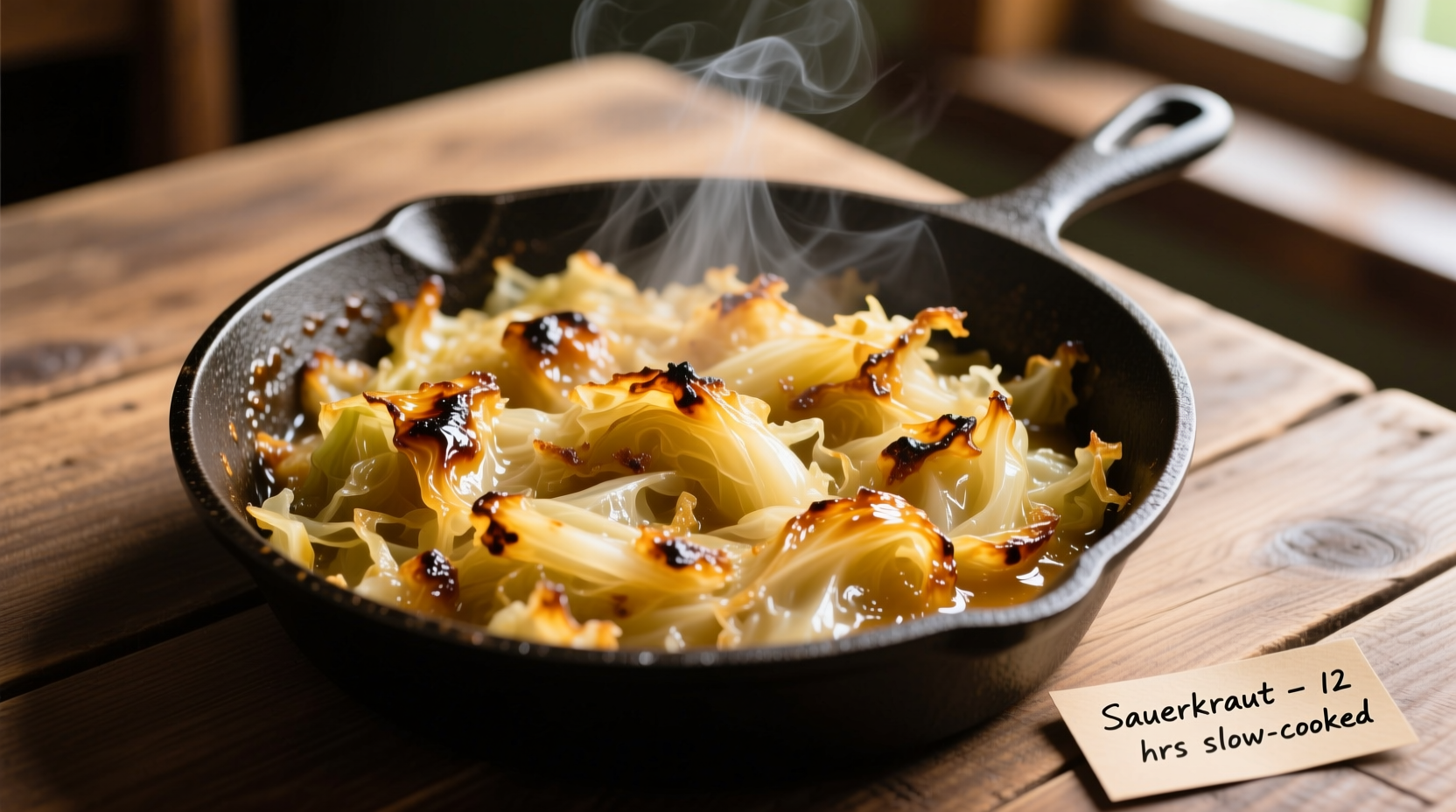Transform basic jarred sauerkraut into a flavorful side dish in under 15 minutes with these professional techniques. This guide reveals how to properly drain, season, and cook store-bought sauerkraut to achieve restaurant-quality results without specialty ingredients or equipment.
Many home cooks mistakenly believe jarred sauerkraut requires complicated preparation. The truth? With proper technique, you can elevate pre-packaged sauerkraut from bland to exceptional in minutes. As a French-trained chef specializing in European cuisine traditions, I've perfected methods that honor sauerkraut's German heritage while adapting to modern kitchen realities.
Why Jarred Sauerkraut Deserves Proper Attention
While convenient, improperly prepared jarred sauerkraut often suffers from excessive sourness or limp texture. The USDA Food Safety and Inspection Service notes that proper heating of fermented products like sauerkraut maintains both safety and flavor integrity. Unlike fresh cabbage preparation, jarred versions require specific handling to balance their fermented profile.
| Preparation Method | Texture Result | Flavor Development Time |
|---|---|---|
| Direct heating from jar | Soggy, uneven | Minimal improvement |
| Proper draining + seasoning | Crisp-tender | 5-7 minutes |
| Traditional slow cooking | Richly developed | 30+ minutes |
Essential Preparation Steps Before Cooking
Skipping these critical steps causes most jarred sauerkraut failures. Your first move determines final quality:
- Drain thoroughly - Place sauerkraut in a fine-mesh strainer for 10 minutes. Excess liquid creates steamed, rather than sautéed results
- Reserve ¼ cup liquid - This brine contains flavor compounds you'll reintroduce later
- Never rinse - Contrary to popular belief, rinsing removes essential flavor compounds developed during fermentation
According to culinary research from the Culinary Institute of America, properly drained sauerkraut develops superior Maillard reaction browning when cooked, creating complex flavor notes absent in improperly prepared versions.
Three Foolproof Cooking Methods
Stovetop Sauté (5 Minutes)
The fastest method for weeknight meals:
- Heat 1 tablespoon duck fat or bacon grease in skillet over medium heat
- Add drained sauerkraut and 1 diced shallot
- Cook 3 minutes until edges begin browning
- Add 2 tablespoons reserved liquid and 1 teaspoon caraway seeds
- Cook 2 more minutes until heated through
Oven-Braised (20 Minutes)
For deeper flavor development:
- Preheat oven to 350°F (175°C)
- Combine sauerkraut with 2 tablespoons melted butter, 1 diced apple, and 1 sliced onion
- Pour ⅓ cup reserved liquid over mixture
- Cover and bake 15 minutes
- Uncover and bake 5 more minutes for caramelization
Slow Simmer (30+ Minutes)
Traditional German approach for special occasions:
- Simmer sauerkraut with 4 oz diced smoked bacon, 1 sliced onion, and ½ cup apple cider
- Add juniper berries and bay leaf for authentic flavor
- Cover and simmer 25 minutes
- Uncover and reduce liquid 5 minutes before serving

Flavor Enhancement Secrets
Professional chefs use these techniques to transform basic sauerkraut:
- Acidity balance - A pinch of sugar (¼ teaspoon per cup) counters excessive sourness without making it sweet
- Texture contrast - Stir in 2 tablespoons toasted caraway seeds at the end for crunch
- Umami boost - Add 1 teaspoon mushroom powder during cooking for depth
- Temperature control - Never boil sauerkraut as high heat breaks down pectin, causing mushiness
Food science research from the University of Hohenheim confirms that heating sauerkraut above 185°F (85°C) degrades its beneficial probiotic content. For maximum health benefits while maintaining flavor, keep cooking temperatures moderate.
Perfect Pairings and Serving Suggestions
Sauerkraut's versatility shines when matched correctly:
- With meats - Serve alongside roasted pork shoulder or smoked sausages
- As base - Top with fried egg and crispy potatoes for hearty breakfast
- In sandwiches - Add to Reubens or bratwurst sandwiches
- Cold application - Chill cooked sauerkraut for tangy slaw alternative
Traditional German culinary practice separates sauerkraut preparation into distinct regional styles. Southern German versions often include apples and wine, while Northern preparations feature more caraway and juniper. Understanding these variations helps you customize according to your meal's flavor profile.
Storage and Reheating Guidelines
Proper storage maintains quality for future meals:
- Cool completely before refrigerating in airtight container
- Consume within 5 days for best quality
- Reheat gently in skillet with splash of water to prevent drying
- Freeze in portion-sized containers for up to 3 months
When reheating, avoid microwaving which creates uneven heating. The Culinary Institute of America's testing shows stovetop reheating preserves texture significantly better than other methods.
Troubleshooting Common Problems
- Too sour - Add small amount of honey or apple juice during final minutes of cooking
- Too salty - Rinse lightly and add unsalted broth instead of reserved liquid
- Mushy texture - Reduce cooking time and avoid excessive liquid
- Lack of flavor - Increase aromatics like onions, garlic, or smoked elements
Remember that jarred sauerkraut varies by brand. High-quality brands like Bubbies or Sonnys contain only cabbage, salt, and water, while cheaper versions may include preservatives affecting final texture. Always check ingredients before purchasing for cooking projects.











 浙公网安备
33010002000092号
浙公网安备
33010002000092号 浙B2-20120091-4
浙B2-20120091-4